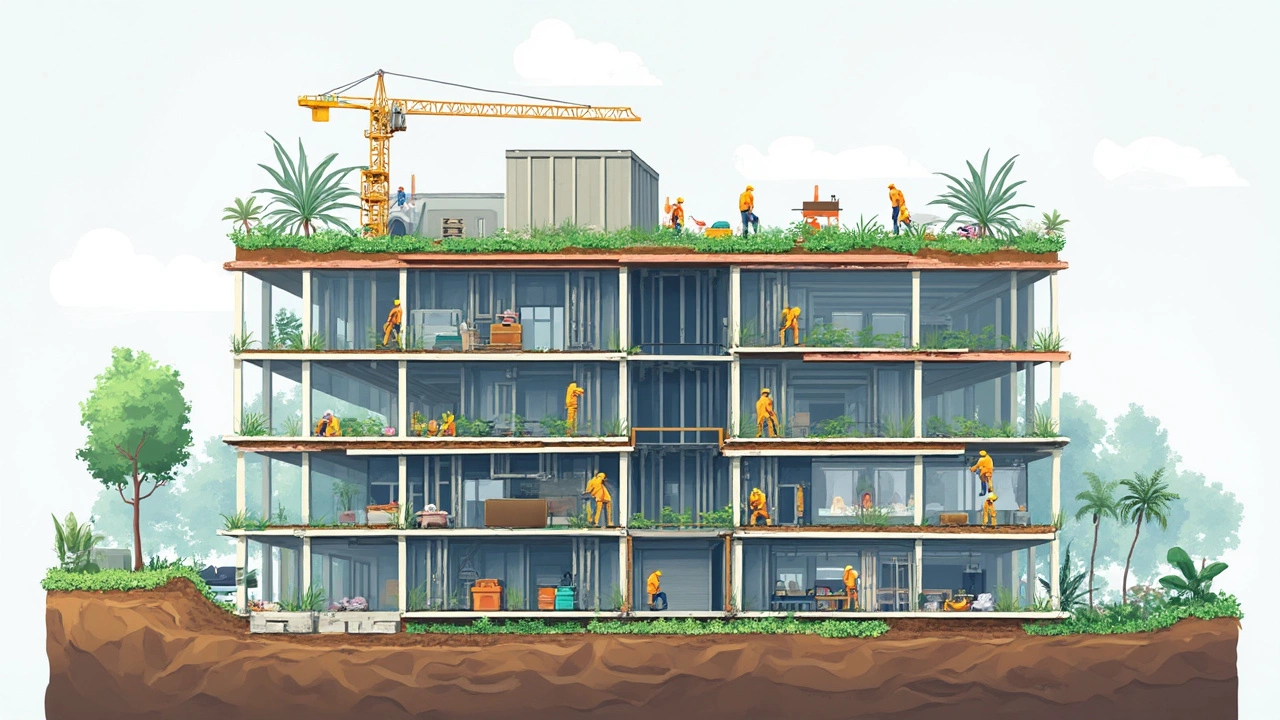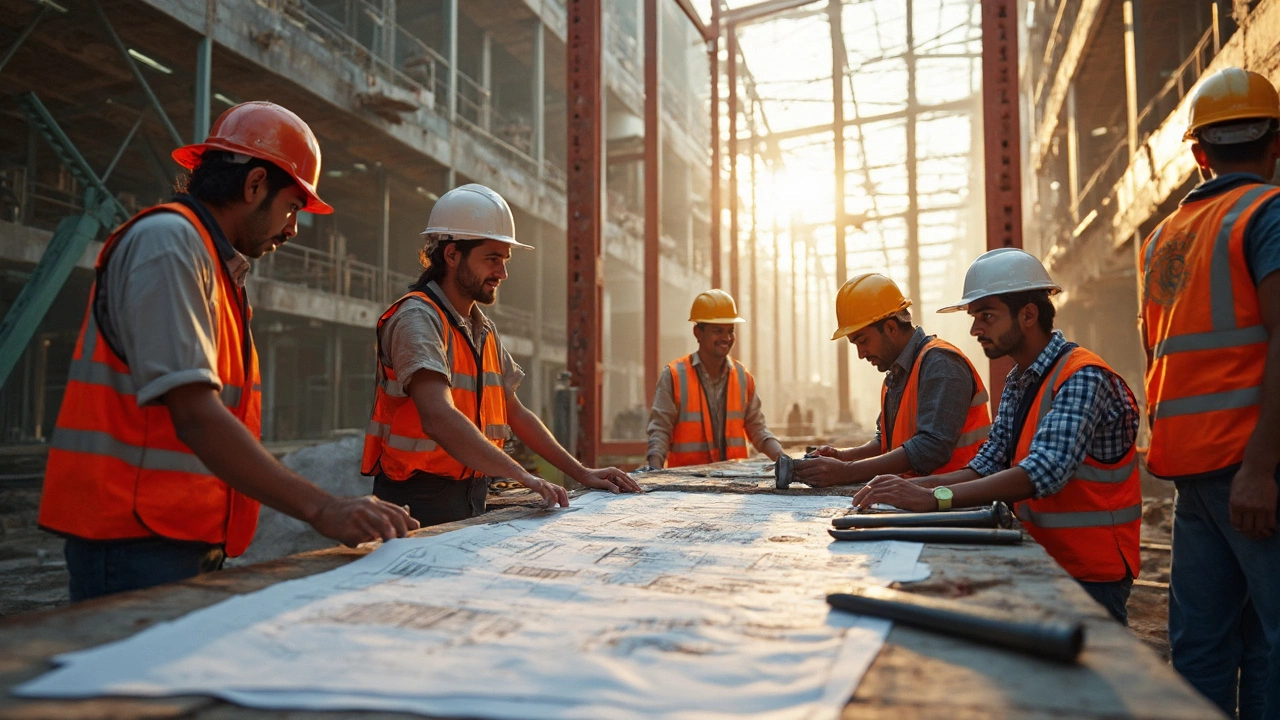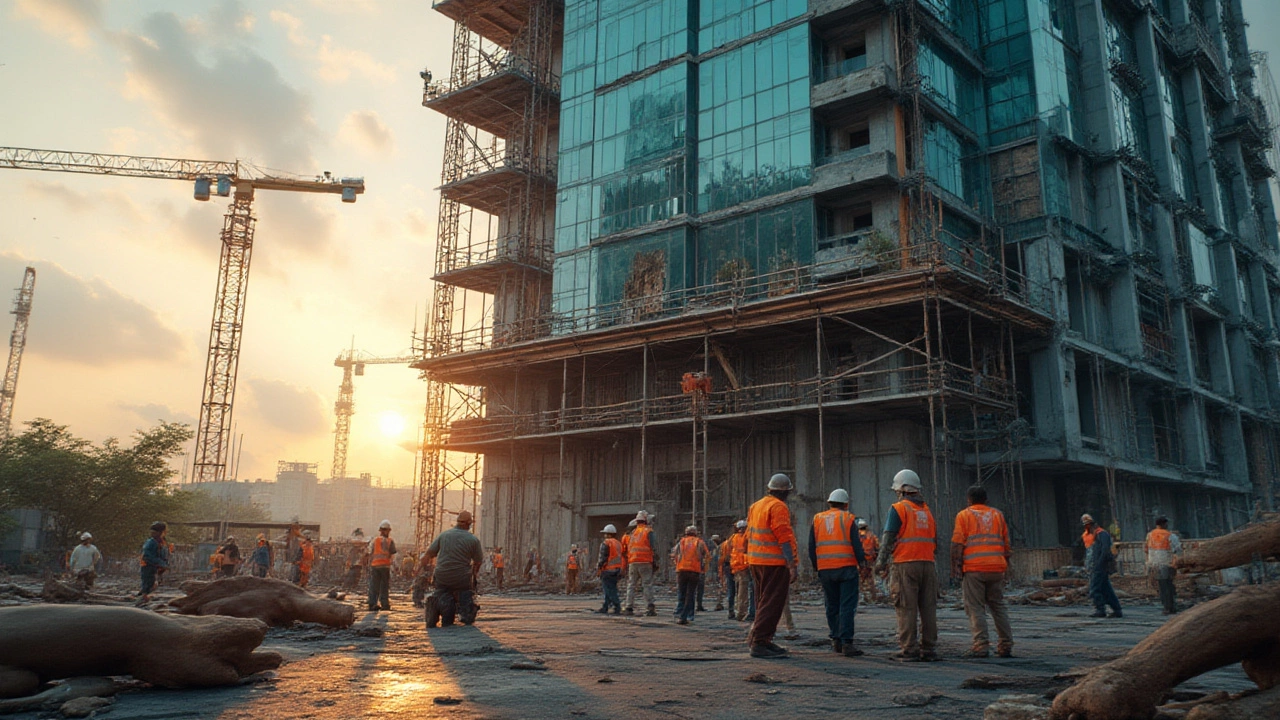Ever look at a new office building breaking ground and wonder what actually makes it stand up? Commercial construction isn’t just about tossing up some walls and calling it a day. There are real steps, choices, and tried-and-true methods behind every project—right down to how the first beam gets placed or the kind of panels they use for those glassy, modern-looking walls.
Businesses care about speed, safety, and cost, and the way a building is constructed plays a massive role in all of that. Want your new space open in half the time? Some construction methods can make that happen. Want a stronger building that stands up to crazy weather? Picking the right frame and material makes all the difference. If you’re planning a project or just want to know how the pros make it happen, understanding commercial construction methods can save you a pile of money and even more headaches down the road.
- Pre-Construction Planning
- Traditional Concrete and Steel Framing
- Modular and Prefabricated Construction
- Tilt-Up and Precast Techniques
- Green and Sustainable Methods
- Smart Construction Tips
Pre-Construction Planning
If you skip pre-construction planning, you’re asking for trouble. Every successful commercial construction project starts here—before a shovel ever hits the dirt. This phase is all about making solid choices that set up the rest of the job for smooth sailing instead of big surprises.
The first thing pros do is hammer out a realistic budget. This covers everything: permits, project management, materials, labor, equipment, and of course, that ever-present buffer for when things don’t go as planned. According to a report from the National Association of Home Builders, overruns hit about 14% of commercial projects—usually from skimping on planning.
You’ll also see lots of scheduling talk. Keeping things on track means plotting out every step on a timeline, so suppliers, crews, and inspectors stay on the same page. And speaking of pages, don’t forget about blueprints, environmental assessments, utility checks, and site surveys. All of it happens before construction even thinks about starting.
- Site Evaluation: Every plot has quirks—like soil issues, flood risks, or property access headaches. Skipping a deep dive on the land can send the whole job sideways.
- Permitting: Permits take time. Get the paperwork rolling early or watch your timeline slip by weeks (sometimes months).
- Procurement: Lock down your suppliers and material orders well in advance. Delays here ripple out and push everything else back.
- Stakeholder Communication: Clear updates to owners, investors, and inspectors will keep surprises to a minimum and trust high.
Check out this simple breakdown of what gets sorted out in pre-construction:
| Key Task | Why It's Critical |
|---|---|
| Budget Set-Up | Prevents costly overruns |
| Site Survey | Reveals land problems early |
| Permit Filing | Avoids legal delays and fines |
| Scheduling | Keeps build on track |
| Supplier Contracts | Secures materials before shortages hit |
Invest the time here, and you sidestep the classic mistakes—like seeing crews waiting around while engineers hash out missing details, or stopping the job for last-minute permit snags. In short: nail this stage, and the rest of construction gets way easier.
Traditional Concrete and Steel Framing
When you think of classic downtown high-rises or big box stores, chances are they’re built with either concrete or steel framing—or a mix of both. These methods have been the backbone of commercial construction for decades. Why? They can handle huge loads, last a long time, and stick to strict safety codes. Plus, banks and insurers love how predictable these systems are.
Concrete framing usually means pouring concrete into forms on-site, letting it harden, and reinforcing it with steel bars or mesh. This is called “cast-in-place” concrete. On the flip side, steel framing uses beams and columns, shipped in pieces and assembled like a huge erector set. Here’s a quick breakdown of the two:
- Concrete Framing: Takes longer to build because you have to wait for it to cure, but it’s awesome for soundproofing and fire resistance. Multi-level parking garages and hospitals love this approach.
- Steel Framing: Easy to assemble super tall buildings fast—think sports arenas or office towers. Bonus: Steel structures can flex a little during earthquakes or high winds, which is a big deal in some cities.
Check out how these two stack up in the real world:
| Feature | Concrete Framing | Steel Framing |
|---|---|---|
| Construction Speed | Slower (due to curing time) | Faster (pieces pre-made, just bolt together) |
| Ideal Use | Parks, parking garages, hospitals | Tall offices, shopping centers, stadiums |
| Strength | Great under compression | Great in tension and compression |
| Fire Resistance | High | Needs fireproofing spray or wrap |
| Flexibility | Low (brittle) | High (slightly flexible) |
One helpful tip: If your site access is tight—think downtown with little space for staging—steel framing can be a lifesaver. The big pieces go up with cranes, and there’s less need for a giant storage yard. Meanwhile, concrete framing jobs might need more space, and plan for weather delays, since heavy rain can ruin a pour day.
Both approaches work with modern tech like building information modeling (BIM), so you can plan out exactly where every beam and column goes before breaking ground. That means less rework and more savings. Want quieter office floors and a solid, sturdy feel? Concrete’s your friend. Want to hit a deadline and keep your skyscraper costs in check? Steel's the go-to.
Modular and Prefabricated Construction
If you want to finish a project faster or avoid most of the usual on-site mess, modular and prefabricated construction is hard to beat. Here’s the gist: most of the building, whether it’s walls, floors, bathrooms, or even entire rooms, gets built in a factory. These chunks—called modules or panels—are shipped to the site, where workers snap or bolt them together like giant Legos. This method has been around in some form for decades, but it's gained real popularity for schools, hotels, and even hospitals in the last 10 years.
Why is it such a game changer? For one, your timeline can shrink by 30-50% compared to old-school building. No bad weather delays. No waiting around for concrete to set. Projects can move even while foundations are being dug. Workers in factories don’t have to worry about rain or freezing mornings, so quality often comes out better (and, yes, fewer surprise delays).
In terms of tech, you’ll commonly see two types:
- Modular construction: Big sections of a building are made indoors—think whole hotel suites or office pods. You piece them together onsite.
- Panelized/precast methods: Flat walls, floors, or roofs are cast or built offsite. Once delivered, they’re lifted into place, sometimes even in a single day for smaller buildings.
A cool fact: In 2024, a 24-story apartment tower in Brooklyn was finished in just 14 months using modular methods—almost a year faster than it would’ve taken with traditional concrete and steel framing.
For anyone dealing with high labor costs or tight project schedules, this approach can save big on both time and money. But keep in mind, it needs tons of up-front planning and precise coordination between the factory and onsite teams. Changing the plans halfway through? That’s tough once parts start coming off the assembly line.

Tilt-Up and Precast Techniques
Tilt-up and precast construction methods have completely changed how fast and efficiently big commercial buildings get built. If you’ve ever seen a crew pouring massive concrete panels right on the ground, then lifting them into place with a crane, you’ve seen tilt-up in action. For precast, those panels or building parts are made in a factory, hauled to the job site, and set in place like giant building blocks.
Tilt-up is super popular for warehouses, shopping centers, and schools. Why? It’s speedy and cost-effective—once the foundation is done, big wall panels get poured, cured, and lifted up all on site. According to the Tilt-Up Concrete Association, over 15% of industrial buildings in the U.S. now use tilt-up. Even some major retailers go for it to save money on both time and labor.
Precast brings its own perks. Since panels are made under controlled conditions, there’s less chance of bad weather slowing things down or messing up the mix. The quality control is tighter, so you’re less likely to find a crooked panel or off-color patch. Hospitals, parking garages, and stadiums often go for precast for that reason. Both methods seriously reduce framing and exterior work time compared to traditional builds.
- Commercial construction pros pick tilt-up for big, simple buildings where speed and cost matter most.
- Precast fits when you want better finishes or have parts that need to fit just right, like special facades or columns.
- Both methods need cranes on site, and you have to plan early—doors, windows, and electrical cutouts all get cast in from the start.
Here’s a quick look at how tilt-up and precast stack up side by side:
| Feature | Tilt-Up | Precast |
|---|---|---|
| Where built? | On site | Factory off site |
| Panel size | Can be huge—often 40 ft wide | Shipped by truck, so usually smaller |
| Speed | Fast after slab is done | Faster if you factor in factory work |
| Weather delays | Possible | Rare |
| Cost | Lower for big, simple buildings | Higher for shipping but great for complex work |
Quick tip: Always involve your designer and contractor early if you want to use these techniques since every opening or support has to be in the plan from day one. Retrofits are possible, but they’ll cost you.
Green and Sustainable Methods
Building green in the commercial world isn’t just about good karma—it’s turning into a smart business move. Tenants, investors, and even city governments are pushing for spaces that use less energy, waste fewer materials, and cost less to operate over time. In 2024, over 45% of new commercial builds in the U.S. included some sustainable features, and the number just keeps climbing.
The most common approach is picking earth-friendly building materials. Things like recycled steel, low-VOC paints, reclaimed wood, and insulated concrete forms are everywhere now. Solar panels on rooftops? Pretty standard on new offices or warehouses, and not just in sunny states. These days, large window systems with high-efficiency glass are also a big hit—they let in more natural light, which actually helps cut down office energy bills by up to 18% according to a 2023 Department of Energy report.
Another big one: green roofs. These aren’t just for looks. Adding plants and soil to rooftops improves insulation and soaks up rainwater, which keeps buildings cooler and cuts down on runoff. Some shopping centers and offices even use living walls inside for air quality. And if you’re working on a warehouse or big-box store, consider something called cool roofing—a white or highly reflective roof that bounces sunlight and keeps indoor temps reasonable without cranking the AC full blast.
Going greener in commercial construction starts at the design phase. A lot of projects aim for certifications like LEED (Leadership in Energy and Environmental Design) or BREEAM, which set tough standards for energy use, indoor air, water, and even how workers are treated on-site. Some cities offer tax breaks if you hit these marks, so it’s worth checking the local rules before construction starts.
- Pick local materials: Cuts shipping costs and emissions.
- Plan for energy efficiency: Think high-efficiency HVAC, smart lighting, and weatherproofing at every entry point.
- Manage water: Install low-flow fixtures, rainwater harvesting systems, and drought-resistant landscaping.
- Recycle construction waste: Separate steel, wood, and drywall so less ends up at the dump.
Here’s how green features stack up in recent commercial projects:
| Sustainable Feature | Common Usage Percentage | Estimated Savings |
|---|---|---|
| LED Lighting | 63% | 20-30% less electricity |
| Solar Panels | 38% | Average $0.13/sq ft annual savings |
| Green Roofs | 19% | Insulation + up to 40% stormwater absorption |
| Low-VOC Materials | 51% | Healthier air |
Before breaking ground, talk to your builder about sustainable upgrades. Sometimes, spending a few percent more upfront ends up saving a fortune later. And if you ever plan to sell, greener buildings are getting higher valuations than the old gas-and-glass dinosaurs.
Smart Construction Tips
Getting the most out of commercial construction isn’t rocket science, but there are a few proven moves the best builders swear by. Some of these tips can spare you major costs, headaches, or schedule delays.
First, don’t skip the planning stage. Having clear blueprints and detailed schedules up front can save weeks of “fix-it” work later. Even today, poor planning is the top reason projects go over budget or behind schedule.
- Invest in design-build services: Bringing in teams that handle both design and construction in-house often shaves months off the timeline. There are fewer miscommunications and less finger-pointing.
- Choose the right materials for your climate: Steel and concrete perform differently depending on heat, humidity, and storms. For instance, steel frames are great in dry areas, but concrete often holds up better where hurricanes or floods are a threat.
- Embrace technology: Tools like building information modeling (BIM) spot problems before crews ever hit the site. You get fewer surprises and more accurate cost predictions.
- Order materials in bulk, but smartly: Buying supplies all at once can snag you lower prices. Just watch for storage or spoilage issues—especially with things like lumber, which warps if left in the rain.
- Always double-check building codes early: City inspectors don’t care about excuses. Missing one small code line often means expensive rework or even having to tear out finished walls.
Want a reality check on why this all matters? Here’s how experts peg the impact of good planning on commercial builds:
| Factor | Time Saved | Cost Savings |
|---|---|---|
| Clear planning & scheduling | Up to 18% | Up to 13% |
| BIM adoption | Up to 10% | Up to 9% |
| Design-build method | 2-4 months per year-long project | 5-7% |
Bottom line, commercial construction rewards those who prep smart, pick the right team, and lean on tech to find problems before anyone touches a wrench. Whether you’re putting up a coffee shop or a big box store, these habits stack the odds in your favor.



